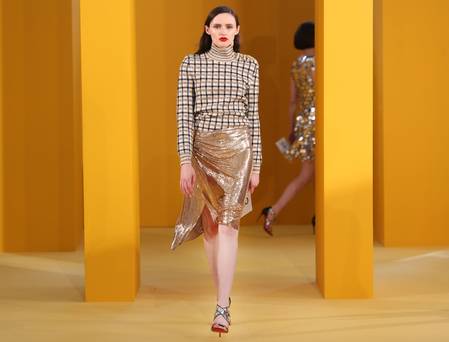Paco Rabanne anyone? The label may sound familiar to some, but many consumers will probably make a beauty connection first before fashion.
They will undoubtedly think of perfumes, in particular, the ‘Pour Homme’ fragrance in its famous square green bottle. Men adore its sophistication and women help themselves to sneaky sprays of it. In short, it’s a classic. Unfortunately, the fashion side of the business has not been so buoyant. For years it was one of France’s top brands, up there with Courrèges and Pierre Cardin but it seemed to lose its footing on the fickle ladder of fashion. Cue change in the form of the super-talented designer, Julien Dossena (pictured below) whose injection of energy and dynamism has rebooted the brand and massively turned its fortunes around. It’s certainly put the name Paco Rabanne back on the fashion landscape and on to people’s lips.
Please log in or register with Independent.ie for free access to this article.
Log In
New to Independent.ie? Create an account
The Breton designer was appointed creative director at Paco Rabanne in 2013. Before that he had worked at Versace and his last position was at Balenciaga where he worked alongside Nicolas Ghesquière.
Over the last few years, Julien has earned international praise for making the once famous label exciting, and more importantly, relevant again. Judging by the reaction to his silver sequin dress (left) at the recent curtain opener on the Brown Thomas new season buy, there’s little doubt that Julien has supreme ability to capture sensuality and celebrate a woman’s body.
This story about the latest chapter in a heritage brand cannot proceed further without a step back in time because context has so much importance. The man who started it all, Francisco Rabaneda Cuervo came from the Basque country and when he emerged in the 60s, he was more commonly known under the pseudonym of Paco Rabanne. The Spaniard was regarded as an enfant terrible of the French fashion world and was famed for his futuristic dresses made of plastic discs.
Francisco got his start in 1966 with the collection named ’12 Unwearable Dresses in Contemporary Materials.’ He had used metal, plastic, rubber and cardboard. He was a risk-taker. He experimented with paper, knitted-fur and fibreglass and dressed, among others, the high priestesses of cultural life in France, namely the singer Françoise Hardy and the actress Brigitte Bardot. One of his most famous pieces was the green costume worn by Jane Fonda in the 1968 science-fiction film Barbarella. A genius at surface work, I was intrigued in my research to discover how Francisco was known as an “accessoriste” and his favourite medium was plastic. He took wafer thin rhodoid discs, lit them with silver and bright fluorescent colours like yellow, orange and shocking chartreuse and strung them together. The result was ground breaking evening wear. Fast forward to the present day where Julien Dossena is delivering striking collections full of original, modern thinking with diverse tactile experiences, everything from look-at-me, space-age chain mail and metallics to soothing velvets and cheeky checks.
Julien débuted his own work at Paco Rabanne in SS14, sending out mini dresses spiked with metallic accents and just as Francisco had done 50 years earlier, the collection commanded the industry’s attention. However, in what should surely be a masterclass for other designers taking over the reins of a famous label, Julien remained an independent thinker and rather than dive straight away into the design house’s archives, to find his Paco Rabanne feet so to speak, he resisted.
He says he didn’t want to be influenced and was wise, preferring to write his own opening chapters. But he has spoken of how much he was interested in how Rabanne was one of the first designers to address a new generation of women who did not want to dress like their mothers. Like Rabanne did, Julien gives the modern woman options, whether she wants safe, like a beautified little pink cardigan adorned with crystal embellishment worn over a velvet dress with boots. But they are attitudinal boots, cropped, leather, straight from western plains styling. Or maybe the modern woman seeks out high-necked and long-sleeved but in a dress that is quietly sexy because of its cut. Or maybe she rocks loud checks worn with a gold mesh skirt that wraps around your limbs like a sexy second skin. It’s six years since Julien took over the reins but it was only in 2017 that he went back in time to acknowledge Rabanne’s signature chain mail designs. Back in the day, Rabanne’s originality had a seismic impact on the fashion world with his mod fashions for the ‘youthquake’ generation but Julien is now having that too.
He exudes a cool youthfulness and an interest in modernity while at the same time respecting the heritage. His AW19 collection, one of the new labels to arrive into Brown Thomas this season, provides ample proof of his user-friendly vision. By his own admission, one month he can be totally obsessed by minimalism, another he’ll explore old glamour. There is a palpable organic thread running through the generations. Julien’s activewear obliquely references Paco Rabanne’s latter-day fragrances, with names like Invictus and Olympéa. Now his success is being recorded beyond the fashion media and pops up on the business pages.
The 2018 sales of Paco Rabanne were double those of 2017 and the same rate of growth is expected again this year. And whatever happened to Francisco? He is 85 years of age but 20 years ago gave up his career and left Paris, convinced that the Russian space station Mir was about to crash-land and destroy the city during a solar eclipse. It didn’t happen but his fashion dream lives on and his passion for modern and futuristic design is now being told with great success by a new man in a new millennium.
Source: Read Full Article



